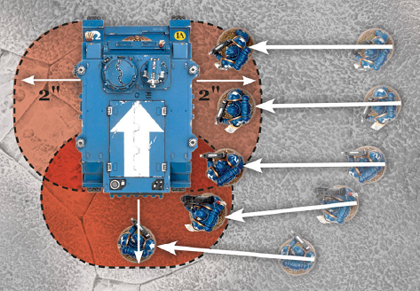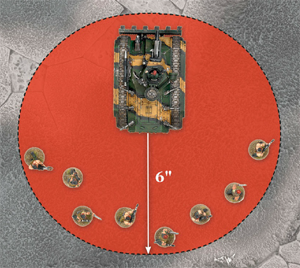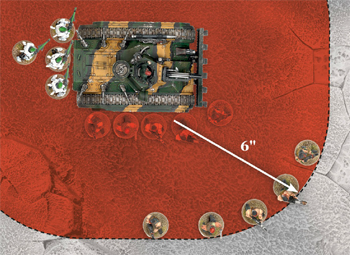Some vehicles can carry infantry across the battlefield, providing speed and protection. Of course, if the transport is destroyed, the passengers risk being burnt alive in the explosion. Transports have several additional characteristics: Transport Capacity, Fire Points and Access Points.Each Transport vehicle has a maximum passenger capacity that can never be exceeded. A Transport can carry a single Infantry unit and/or any number of Independent Characters (as long as they are also Infantry), up to a total number of models equal to the vehicle’s Transport Capacity. The entire unit must be embarked on the Transport if any part of it is – a unit cannot be partially embarked or be spread across multiple Transports. Only Infantry models can embark upon Transports (this does not include Jump or Jet Pack Infantry), unless specifically stated otherwise. Some larger Infantry models count as more than one model for the purposes of Transport Capacity, and this will be specified in the model’s rules. Sometimes, there will be constraints on which types of models can embark upon a particular vehicle, and this will be specified in the unit’s entry. Space Marine Terminators, for example, cannot embark upon a Rhino or Razorback, although they can be transported by a Land Raider. For example, a Rhino bought for a Space Marine Tactical Squad (troops) counts as a unit of troops, but one bought for a unit of Space Marine Sternguard Veteran Squad (elites) counts as elites. Other vehicles may also have a Transport Capacity, but they are chosen separately as normal, have a role and occupy a force organisation chart slot of their own. The only limitation of a Dedicated Transport is that when it is deployed, it can only carry the unit it was selected with (plus any Independent Characters that have joined it). After the game begins, it can then transport any friendly Infantry unit, subject to Transport Capacity and other special exclusions, as explained in the vehicle’s entry. Many Transports have a number of Fire Points defined in their army entry. A Fire Point is a hatch or gun slit from which one or more passengers inside the vehicle can fire shooting weapons (or use witchfire psychic powers). Unless specified differently in the vehicle’s entry, a single passenger can fire out of each Fire Point and the other transported models cannot fire. Ranges and line of sight are measured from the Fire Point itself. If an embarked model fires a Template weapon or a beam psychic power from a Fire Point, discount the hit scored against the vehicle – we assume the weapon has been fired in a sufficient arc to clear the Transport’s hull. Note that the passengers can shoot at a different target to the vehicle itself. Models firing out of a vehicle that moved at Combat Speed count as having moved that turn. Models firing out of a vehicle that moved at Cruising Speed can only fire Snap Shots that turn. They cannot fire if the vehicle moves Flat Out or uses smoke launchers that turn, nor can a vehicle move Flat Out or use smoke launchers if a unit embarked inside it shoots out. Each vehicle capable of carrying passengers will have a number of Access Points defined in its entry. These are the doors, ramps and hatches that passengers use to get in and out of the vehicle (see below for more details). Transports on flying bases also count the base as an Access Point. Models can only voluntarily embark or disembark in the Movement phase. They cannot voluntarily embark and disembark in the same turn. However, they can embark and then be forced to disembark if their Transport is destroyed.  If the vehicle moved before its passengers got aboard, it cannot move further that turn (including pivoting on the spot, moving Flat Out, Running or charging). If the vehicle did not move before its passengers got aboard, it can move as normal after they have embarked. In either case, a vehicle cannot Tank Shock or Ram in a turn that a unit embarks upon it. If the vehicle had not moved before the unit disembarked, the vehicle can then move normally. If the vehicle had already moved before the unit disembarked, the vehicle cannot move further that turn (including pivoting on the spot, moving Flat Out, Running or charging). In addition, a vehicle cannot Tank Shock or Ram on a turn that a unit disembarks from it.  The model can then make a normal move – Difficult and Dangerous Terrain tests should be taken as normal, but it must end its move wholly within 6" of the Access Point it disembarked from (we assume that any distance that is lost because of this has been used getting out of the Transport). Repeat this process for each model in the unit. At the end of the unit’s move, all models must be in unit coherency.  If an Independent Character (or even more than one) and a unit are both embarked upon the same vehicle, they are automatically joined, just as if the Independent Character was within 2" of the unit. If either an Independent Character or a unit is already in a vehicle, the other may join them by embarking too (assuming, of course, that there is enough space). The unit and the Independent Character(s) can, in a later Movement phase, disembark together as a single unit. Alternatively, they can separate by either the unit or the Independent Character(s) disembarking while the others remain on board. They can even separate by disembarking at the same time, so long as they end their moves more than 2" away from each other. If a Transport vehicle is assaulted, an embarked unit can fire Overwatch at the attackers out of its Fire Points – note that a unit can still only fire Overwatch once a turn, even if embarked on a Transport. If a Transport vehicle is Wrecked, Explodes! or Crashes and Burns, any Wounds caused to its passengers do not count towards assault results, and any surviving passengers are not locked in combat with the units assaulting their vehicle. Psykers embarked on a Transport can only target enemy units with witchfire psychic powers, and only then if the vehicle has a Fire Point that can ‘see’ the target unit. Psykers embarked on a Transport cannot attempt to manifest any other kind of psychic power. Psychic powers cannot target units that are embarked on a Transport. When a Transport sustains damage, it can also have an effect on its passengers – even if they disembark – as described below:
FAQTransports
|

